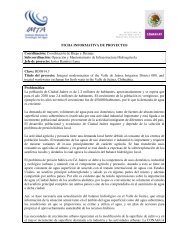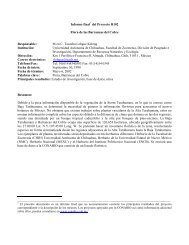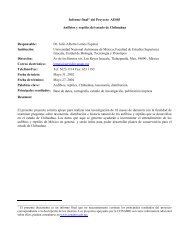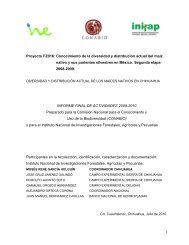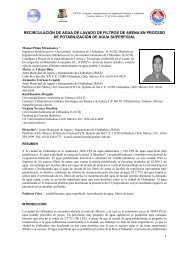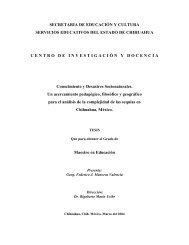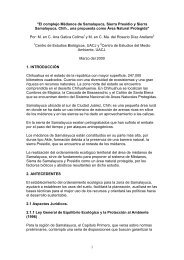land use and land tenure change in the - El Colegio de Chihuahua
land use and land tenure change in the - El Colegio de Chihuahua
land use and land tenure change in the - El Colegio de Chihuahua
Create successful ePaper yourself
Turn your PDF publications into a flip-book with our unique Google optimized e-Paper software.
18of five, ten or fifteen years. Un<strong>de</strong>r NAFTA, US exports of gra<strong>in</strong>s, <strong>in</strong>clud<strong>in</strong>g corn, wheat, rice <strong>and</strong>soybeans, have <strong>in</strong>creased <strong>and</strong> are expected to cont<strong>in</strong>ue to rise. US exports of cotton, pork, <strong>and</strong> chicken havealso <strong>in</strong>creased, putt<strong>in</strong>g pressures on Mexican producers. As tariff barriers cont<strong>in</strong>ue to be elim<strong>in</strong>ated (<strong>the</strong>ystill exist on corn, dried beans, <strong>and</strong> poultry, for <strong>in</strong>stance), fur<strong>the</strong>r surges <strong>in</strong> U.S. exports <strong>and</strong> related <strong>change</strong>s<strong>in</strong> Mexican production can be anticipated. The U.S. supplies approximately 7% of all of Mexico’sagricultural imports; its share was valued at over $5 billion <strong>in</strong> 1996.(http://www.fas.usda.gov/<strong>in</strong>for/factsheets/nafta.html)The tra<strong>de</strong> <strong>in</strong> both directions has exp<strong>and</strong>ed although U.S. agricultural exports have risen more rapidlythan have Mexican exports to <strong>the</strong> U.S. The U.S. still imposes “safeguard” protections on Mexican exportsof onions, tomatoes, eggplants, chili peppers, squash <strong>and</strong> watermelon. Although horticultural tra<strong>de</strong> <strong>in</strong> bothdirections (<strong>the</strong> U.S. top crops are apples, pears <strong>and</strong> table grapes) is ris<strong>in</strong>g, Mexican exports to <strong>the</strong> U.S. of<strong>the</strong>se products have exp<strong>and</strong>ed at a faster rate, particularly s<strong>in</strong> <strong>the</strong> 1994 <strong>de</strong>valuation of <strong>the</strong> peso. Vegetableexports from <strong>the</strong> US are more than fruit exports from <strong>the</strong> US to Mexico. In 1997 Mexico accounted formore than $1.2 of $1.7 billion <strong>in</strong> fresh vegetable imports to <strong>the</strong> U.S. Tomatoes Accounted forapproximately $517 million of Mexican exports to <strong>the</strong> US <strong>and</strong> 80% of U.S. tomato imports).(http//www.fas.usda.gov/htop/highlights/1998/98-04/fvimp97/98fvimp.html)It is important to note that Mexican agricultural policy is driven not only by a search for <strong>the</strong>expansion <strong>in</strong> vegetable, meat <strong>and</strong> dairy production is driven by <strong>de</strong>m<strong>and</strong>s from Mexico’s rapidly grow<strong>in</strong>gurban areas.It is important to note that Mexican agricultural policy is driven not only by a search for foreigntra<strong>de</strong> through exports, but also by <strong>the</strong> needs of an exp<strong>and</strong><strong>in</strong>g domestic market. Much of <strong>the</strong> expansion <strong>in</strong>vegetable, mean <strong>and</strong> dairy production is driven by <strong>de</strong>m<strong>and</strong>s for Mexico’s rapidly grow<strong>in</strong>g urban areas.As a result of economic <strong>in</strong>stability <strong>and</strong> stagger<strong>in</strong>g national <strong>de</strong>bt, Mexican support for <strong>the</strong> agriculturalsector more responsive to <strong>in</strong>ternational competition <strong>and</strong> tra<strong>de</strong> opportunities, recent adm<strong>in</strong>istrations havealtered or discont<strong>in</strong>ued previous policies that offered consi<strong>de</strong>rable protection to <strong>the</strong> sector. Most of <strong>the</strong>government’s agricultural parastatals have been privatized. This has meant that Mexican producers are nowfac<strong>in</strong>g market prices for many agricultural products <strong>and</strong> services such as fertilizer, commercial seeds,extension, crop <strong>in</strong>surance <strong>and</strong> credit. The system of price guarantees for many commodities has been<strong>change</strong>d, so that producer prices for crops such as barley, wheat, sorghum <strong>and</strong> o<strong>the</strong>r crops are closelyaligned with <strong>in</strong>ternational market prices. Although <strong>the</strong> price of maize <strong>and</strong> beans rema<strong>in</strong>s somewhatprotected, <strong>the</strong>y are gradually be<strong>in</strong>g adjusted to reflect <strong>the</strong> competition. In <strong>the</strong> 1980s, public <strong>in</strong>vestment <strong>in</strong>agriculture fell by more than 80% <strong>and</strong> rural credit by more than half. Subsidies on <strong>in</strong>puts such as fertilizerhave been phased out.In response to large <strong>in</strong>creases <strong>in</strong> <strong>the</strong> number of agricultural loans <strong>in</strong> <strong>de</strong>fault <strong>and</strong> bank seizures offarm<strong>l<strong>and</strong></strong> dur<strong>in</strong>g <strong>the</strong> 1980s economic crises, <strong>the</strong> government reformed <strong>the</strong> rural credit system. The publicagricultural credit bank, BANRURAL, is now operat<strong>in</strong>g on commercial pr<strong>in</strong>ciples, with <strong>the</strong> effect thatcredit availability has <strong>de</strong>cl<strong>in</strong>ed dramatically <strong>in</strong> recent years, particularly for those producers with limitedcollateral or f<strong>in</strong>ancial security.In an effort to cushion some of <strong>the</strong> negative implications of <strong>the</strong>se policy reforms for rural producers,<strong>the</strong> government has <strong>in</strong>itiated a new agricultural program, PROCAMPO, that provi<strong>de</strong>s a direct payment of anestablished amount per hectare to each producer of basic crops (wheat, sorghum, maize, rice, barley, soya,cotton, sunflower, safflower <strong>and</strong> sesame). Although this program was <strong>in</strong>ten<strong>de</strong>d to provi<strong>de</strong> some support to<strong>the</strong> small-scale peasant producers of central <strong>and</strong> sou<strong>the</strong>rn Mexico who were likely to be most averselyaffected by <strong>in</strong>creased competition from imported U.S. gra<strong>in</strong>s, many large-scale commercial producers aref<strong>in</strong>d<strong>in</strong>g that <strong>the</strong> program enables <strong>the</strong>m to cont<strong>in</strong>ue <strong>the</strong> production of o<strong>the</strong>rwise unprofitable crops. ThusPROCAMPO may be provid<strong>in</strong>g an <strong>in</strong>centive for large-scale producers <strong>in</strong> <strong>the</strong> nor<strong>the</strong>rn states to cont<strong>in</strong>ue to<strong>de</strong>vote large areas of <strong>l<strong>and</strong></strong> to crops <strong>in</strong> <strong>the</strong> PROCAMPO program, ra<strong>the</strong>r than convert this <strong>l<strong>and</strong></strong> to o<strong>the</strong>r <strong>use</strong>s.The economic crisis has directly affected agricultural producers who have sought private credit. In1993, estimates of farm loans <strong>in</strong> <strong>de</strong>fault ranged from $1.3 billion to 4 billion <strong>and</strong> banksliberalization/competition, reduced subsidies, <strong>and</strong> a slow economy.





